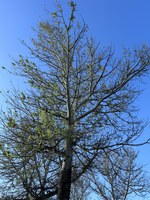Dakota Gardener: Consequences
(Click an image below to view a high-resolution image that can be downloaded)
By Joe Zeleznik, NDSU Extension forester
We’re coming into summer now (June 2024), but I want you to think back about this past winter. What was it like?
For much of the state, temperatures were relatively mild and there was little snow. I shoveled my driveway half a dozen times and never even got out the snowblower. It was great!
But I knew there would be a price to pay for the mild weather and we’re seeing the consequences now.
Over the last few weeks, I’ve received emails with photos of dead trees, or trees with thin crowns and lots of dieback. The species that are damaged run the gamut – maples, elms, European white poplar, lindens, crabapples and birch.
Calls have come from Minot, Williston, Bismarck and Jamestown, and locations in-between.
Generally, we think of mild weather as being good for plants, right? Why was this past winter so tough on trees?
Part of it has to do with variability. Let’s look at some temperatures in Bowman, North Dakota, from this past winter.
The lowest temperature in Bowman last winter occurred on January 13, 2024. It was minus 31 degrees Fahrenheit. On the last day of January, the high temperature there was 65 degrees Fahrenheit.
From February 26 to 28, the temperature dropped from 58 degrees Fahrenheit to minus 12 degrees Fahrenheit. That’s a 70 degree drop in less than 48 hours.
Some trees get fooled by the mid-winter warm-ups and begin to break dormancy. They lose their hardiness and get ready for growth.
And then it gets cold again and they can’t harden up fast enough. We see it every year, yet this year it seemed to be even worse than normal.
“Normal” variability? “Normal” winter death of trees? Yes, it happens.
The lack of snow cover had consequences as well.
While I was happy that I didn’t have to shovel, I felt bad for the snowplowing businesses and the snowmobilers. It was tough on them.
What does that have to do with trees?
Snow insulates the ground, limiting the freezing temperatures in the soil. Without snow, the ground can get awfully cold, and that’s tough on roots.
The soil temperature below the turf in Bowman got to 15 degrees Fahrenheit on January 15, two days after their lowest air temperatures. The previous winter, the coldest the soil got was 29 degrees Fahrenheit. Snow clearly insulates the ground.
Sometimes ornamental trees are grafted. The top of the tree has the characteristics we want – pretty flowers, nice fall color or perhaps a unique crown shape. That tree then gets attached to a root system of the same species or a closely related one. In theory, that root system comes from a tree that’s cold hardy and can survive our winters.
But sometimes, those rootstocks aren’t hardy. We end up with trees that have a different hardiness level in the roots compared to the top. And when we get little-to-no snow cover, that becomes a problem.
As the old joke goes, everyone complains about the weather but nobody does anything about it.
Clearly, there’s nothing we can do to change the weather but we can try to understand how trees deal with the extremes found in our North Dakota environment. They’re fragile and tough, and very complex.
I find them fascinating.
NDSU Agriculture Communication – June 7, 2024
Source: Joe Zeleznik, 701-730-3389, joseph.zeleznik@ndsu.edu
Editor: Kelli Anderson, 701-231-7006, kelli.c.anderson@ndsu.edu




